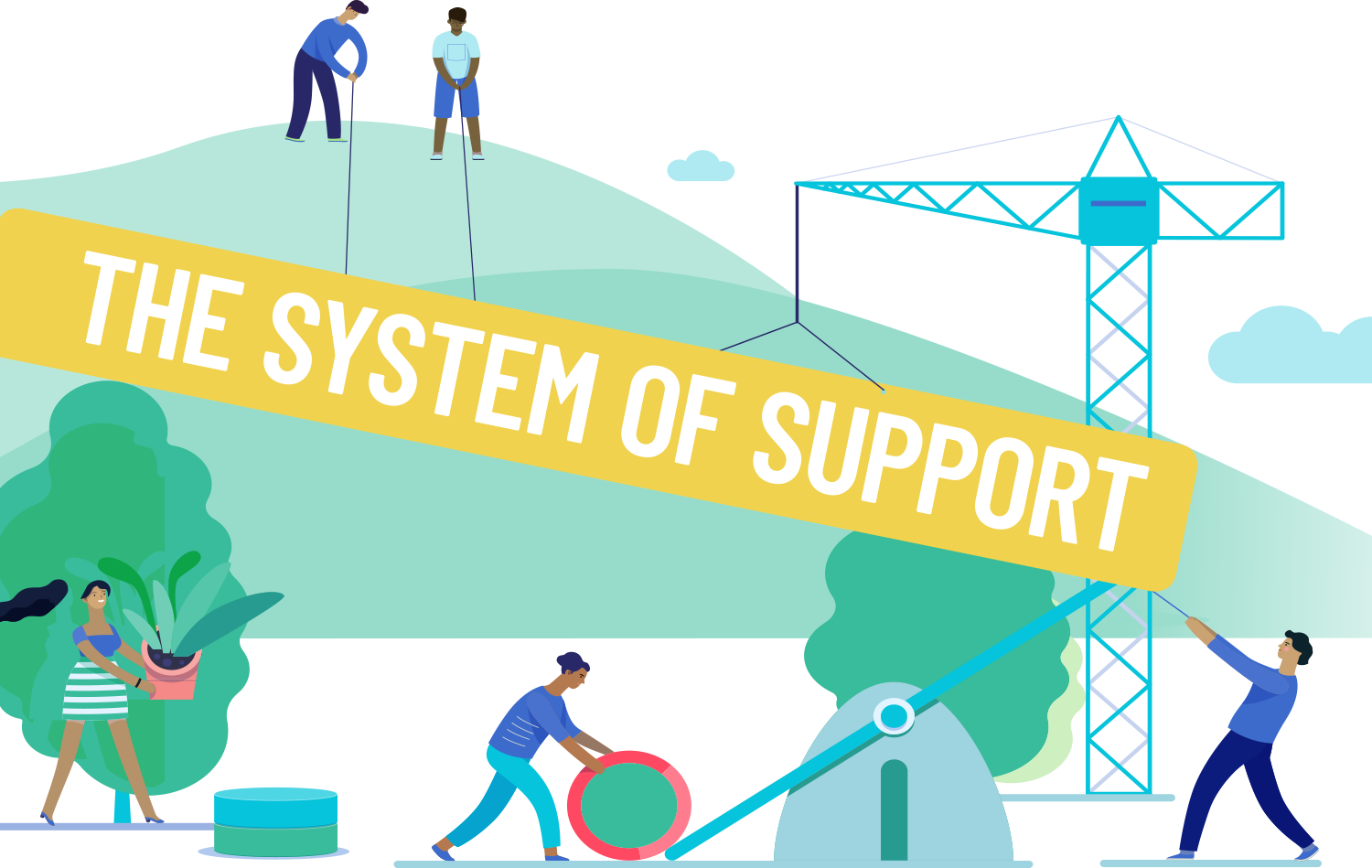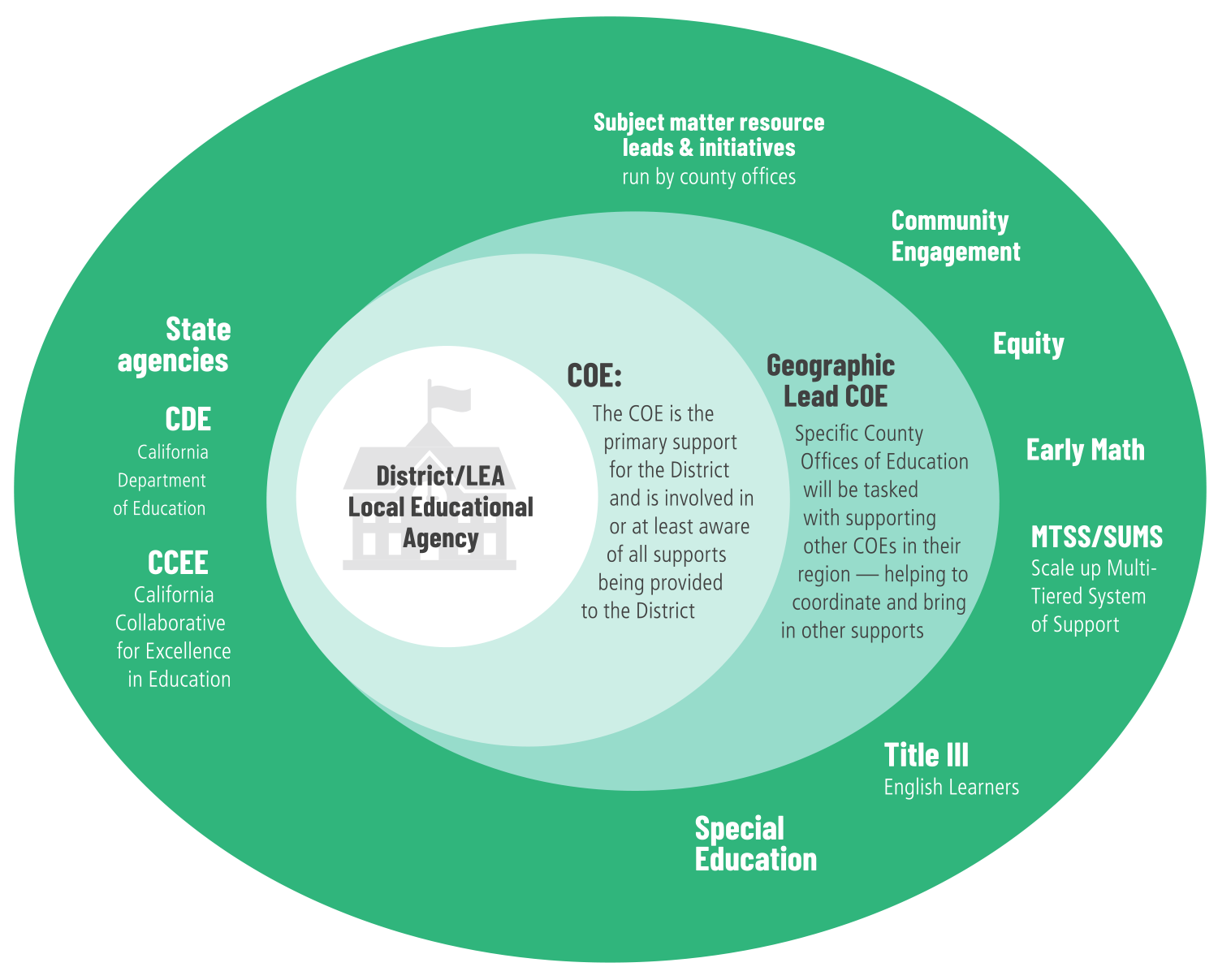
Source: State Board of Education
In the spring of 2017, a new model for improving student outcomes in California was unveiled. Now in its second year of implementation, California’s System of Support was created in response to decades of largely unsuccessful efforts to improve student achievement in the state. This new public school accountability and support system aligns with the Local Control Funding Formula and is fundamentally different from past improvement efforts, representing a practical and cultural shift in the state’s approach to improvement.
Through a focus on capacity-building and the provision of resources and tools to county offices of education and school districts — rather than punitive accountability measures — local educational agencies work in partnership with support providers to improve educational outcomes for all students (see Table 1). Board members have the opportunity to become active partners and integral connectors in this new system.
The System of Support is part of a suite of education policy changes in California under LCFF that shifted the way the state funds, evaluates and supports underperforming school districts. The System of Support is designed to reflect the priorities of LCFF: increasing equity; basing accountability on multiple measures of student performance; and focusing on local control and continuous improvement.
One of the key characteristics that distinguishes the System of Support from other approaches to improving student achievement in the past is a focus on continuous improvement. Continuous improvement is a disciplined and ongoing approach to improving student outcomes and sustaining “persistently higher levels of performance.” A continuous improvement approach — also referred to as improvement science — includes ongoing cycles of data collection and analysis to understand the root causes of poor performance, and to test and refine strategies to improve student outcomes.
The continuous improvement process involves an authentic and sometimes difficult examination by district stakeholders of the practices that are either contributing to or causing a problem in their organization. Of course, these identified problems are ones that, if changed, would have the greatest impact on students, so the problems of practice are high stakes for LEAs. Now after the first year of completing a continuous improvement process with nine districts, we are seeing shifts in mindset. In a discussion with a superintendent, it was affirming to hear his perspective on our continuous improvement process. He stated, “I’m glad we slowed down our tendency to jump to solutions. The process forces you to do that. It forces you to identify a problem and, most importantly, develop an action plan on what caused the problem to occur or root cause… It’s a great process and one I will use over and over going forward.”
Initial responses from district and county leaders to the continuous improvement approach in the System of Support are overwhelmingly positive. Heidi Moore-Guynup, assistant super-intendent of educational services for the Humboldt County Office of Education, noted how the county has taken a learning stance toward their work with districts using the tools of improvement science.
“One of most significant learnings has been the power of transparency with our districts,” she said. “We explain to our districts we are in our own learnings of continuous improvement and invite them to join alongside of us as we deepen our understanding and comfort. This approach has disarmed our districts and has led to very open and candid conversations about the most important asset we share, which is our students.”

A district assistant superintendent similarly noted the value of grounding their work in improvement science, stating, “[Our district] feels that the collaboration with our county office is very beneficial. It allows for an outside look into our systems, from experts who engage in improvement science with the intent to teach concepts and strategies to districts.” Another district superintendent added, “Our COE used the Improvement Science methodology to guide us in the process. Our team felt that the process was very effective at focusing on data and really getting to the root causes of the concern… we seldom have time to look this closely at our data.”
There are three levels of support under the umbrella of the state’s System of Support. Level 1 support, or “support for all,” are resources and assistance such as trainings and voluntary technical assistance that all LEAs have access to, regardless of student performance. An example of Level 1 support is California’s Multi-Tiered System of Supports, which supports LEA efforts to integrate academic, behavi oral and social-emotional learning for all students. Although Level 1 supports will continue to grow and evolve based on locally defined needs, existing statewide efforts in these areas serve as the foundation of resources.
Perhaps the best-known component of the System of Support is Level 2 support, or differentiated assistance. Districts qualify for Level 2 support if one or more student groups underperform on two or more California School Dashboard indicators. The CDE plans to release information on which districts qualify for differentiated assistance in early December 2018. County offices of education and these school districts will then work together to review district data, diagnose the challenges that are leading to low student outcomes and implement strategies to address those challenges through the district’s Local Control and Accountability Plan.
Various state and local agencies provide an array of support resources, tools, and voluntary technical assistance that all LEAs may use to improve student performance at the LEA and school level and narrow disparities among student groups across the LCFF priorities, including recognition for success and the ability to share promising practices.
County Superintendents, the California Department of Education, and the California Collaborative for Educational Excellence provide differentiated assistance, to address identified performance issues, including significant disparities in performance among student groups.
The Superintendent of Public Instruction may require more intensive supports for local education agencies (LEAs) and/or schools with persistent performance issues and a lack of improvement over a specified time period.

As Melissa Bazanos, executive director for assessment, accountability, and continuous improvement at the Riverside County Office of Education explained, “Differentiated assistance is truly differentiated and reinforces the concept of equity. It’s not about every district getting the same thing, but rather, every district receiving support in areas of need in order to better serve their students. Our goal as a COE and as a partner is to support students by meeting the needs of the local context in each district. Services are collaboratively designed with each district and informed by evidence-based approaches and practices.”
Similarly, Colby Smart, director of learning support services in the Humboldt County Office of Education, noted, “Depending on district need and outcomes from the Root Cause Analysis, the [differentiated assistance] Lead then leverages the collective and diverse expertise among HCOE’s [differentiated assistance] team. For example, if a district identifies a need to increase social-emotional curriculum, the MTSS lead would then be brought in to facilitate implementation. The model is meant to be iterative and situational, built on transparency and driven by data.”
According to Diann Kitamura, superintendent of the Santa Rosa City School District, the county office of education offered a critical outside perspective during the differentiated assistance process by helping them “look at root causes in a different way.” Kitamura also anticipated the importance of the county office of education in helping Santa Rosa City SD look at whether their efforts to address these root causes are resulting in improved outcomes, noting, “That’s where outside eyes are so beneficial to the process of change.”
For year two of the System of Support, some districts will be identified to receive differentiated assistance for the first time, some will be identified for their second consecutive year and others will no longer receive differentiated assistance. This presents a new challenge for county offices of education as they plan for the provision of support for school districts.
Although COEs, the California Collaborative for Educational Excellence and the CDE are required to provide customized assistance to school districts that meet the eligibility criteria for differentiated assistance based on student performance, school districts can opt to work with a different support provider rather than their county office of education. Melanie Schoeppe, director of improvement and accountability at the CDE, describes the structure of the System of Support using the analogy of an open door: “With an effective System of Support, when you knock on any door you will get the support or resources that you need. If the person you reach initially can’t offer the support, they will make sure you get to the person that can provide it.”
Level 3 support, or intensive intervention, is intended for districts with persistent underperformance for multiple student groups, when all other attempts at support have been unsuccessful. To qualify for Level 3 intervention, a district must fail to improve student outcomes for three out of four consecutive years, for three or more student groups (or all the student groups if there are fewer than three), or for two or more LCFF priorities. They must also be recommended for intervention by the CCEE, and the intervention must be approved by the State Board of Education. Intervention then occurs under the direction of the State Superintendent of Public Instruction. Districts will not be identified for Level 3 support until the 2019–20 school year at the earliest. Level 3 intervention — and strategies to intervene early when districts are at risk of Level 3 intervention — are currently being defined and developed by a collaborative of state agencies, associations and advocacy organizations, known as the State System of Support Planning Group.
Several county education leaders were asked for their suggestions on how board members could support their district’s improvement efforts under the System of Support. Colby Smart, director of learning support services in the Humboldt COE noted the important role that board members have in communicating about the System of Support to the broader community.
“Understanding the details of education policy and frameworks can be daunting for those not involved in the day-to-day workings of public education,” he said. “A well-informed board can help the broader community understand, interpret and contribute to important shifts in public education. School board members are critically important to helping all Californians understand the impactful work that is going on with the System of Support.”
Additional suggestions from COE leaders on how board members can engage in this work include:
- Become knowledgeable on the multiple components that compose the System of Support: Level 1, Level 2 and Level 3 and their corresponding support structures.
- Familiarize yourself with the needs of students in the district as exemplified through student performance on the Dashboard indicators and other data sources.
- Ensure resources are equitably allocated to meet the needs of students and understand that equitable distribution means that the students with the greatest needs may need more resources than other students.
- If your district receives differentiated assistance, request a copy of the letter sent to your district that identifies strengths/weaknesses after they go through the root cause analysis, and familiarize yourself with it. Include a progress update from district leadership on the differentiated assistance action plan as a standing agenda item for all board meetings.
- Help monitor progress on the Dashboard indicators, create policy to support improved outcomes, advocate for resources to meet the district’s needs, and help the district stay focused on its identified values, vision, mission and goals.
These suggestions represent just a few of the ways that board members can become active participants in the work of improvement in their district under the System of Support. Moreover, they affirm the sentiment shared by Cynthia Glover Woods, chief academic officer for the Riverside County Office of Education, and others: “School board members have an essential role in this work.”
Based on trends in California School Dashboard data, it was evident that additional support was needed for students with disabilities. Moreover, there was a need to better align support for SWDs across divisions at the county office of education and with external agencies. Through differentiated assistance sessions with districts, we discovered that the need to better align support for SWDs also existed within districts and school sites. As a result of these trends, reflections and observations, and through the newly established collaboration at the county level, we determined that we could utilize existing network structures to align support for districts. We determined that the Instructional Leaders Network was an ideal network for discussing services and support for SWDs. ILN meets throughout the year to engage in learning and sharing of best practices related to state priorities and student groups services. Members of the RCOE Educational Services Division, Student Programs and Services Division, and Riverside County SELPA co-plan learning opportunities for ILN participants focused on analyzing data and planning systems and supports for SWDs.
Although it will be several years until the System of Support can be empirically tested to determine whether it leads to improvements in student performance on the Dashboard indicators, survey data on year one of its implementation suggests considerable support for this new approach from a range of education policy leaders at the state, county and district level.
In addition, many county offices of education report specific changes to improve their support for LEAs. According to Dr. Chris Hartley, Humboldt County superintendent of schools, “a major shift in the Humboldt County Office of Education is the integration of departments within the organization to collaboratively work in the support of the districts we serve. The System of Support has been a catalyst for increasing and deepening collaboration among HCOE leaders… Ultimately, resulting in a healthier organization and improved collaboration with our stakeholders.”
Kern COE Superintendent Mary Barlow, similarly reported, “With a focus on the student experience in the system, we are reimagining education from the student perspective. We are seeing more innovative approaches… We have expanded our partnerships with institutes of higher education, businesses and nonprofits to bring much-needed supports to the whole child in a more coordinated, seamless approach.”
Whether this new approach to improvement in the state is successful will take years to determine. However, the early response to the System of Support from a broad range of education leaders suggests its potential for shifting the culture and approach to improvement in the state and ultimately, improving student outcomes. Through the System of Support, California’s education leaders are charting a new course in the nation for how to approach improvement — one that, based on the success of this model — other states may follow.
This article was a collaborative effort by the California Department of Education, California Collaborative for Educational Excellence and State Board of Education.
We sincerely thank the following individuals for their contributions to this article. From Santa Rosa City Schools: Superintendent Diann Kitamura. From Riverside COE: Executive Director for Assessment, Accountability, and Continuous Improvement Dr. Melissa Bazanos; Director JoAnne Lauer; and Chief Academic Officer Cynthia Glover Woods. From Humboldt COE: Superintendent Dr. Chris Hartley; Assistant Superintendent of Educational Services Heidi Moore-Guynup; and Director of Learning Support Services Colby Smart. From Kern COE: Superintendent Mary Barlow; Chief Deputy of Local & Statewide Initiatives Robert Arias; and Assistant Superintendent Instructional Services Lisa Gilbert.